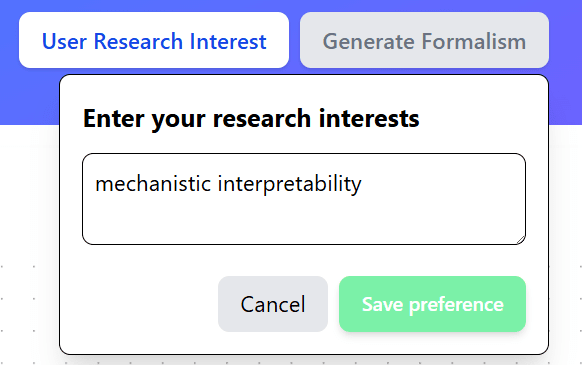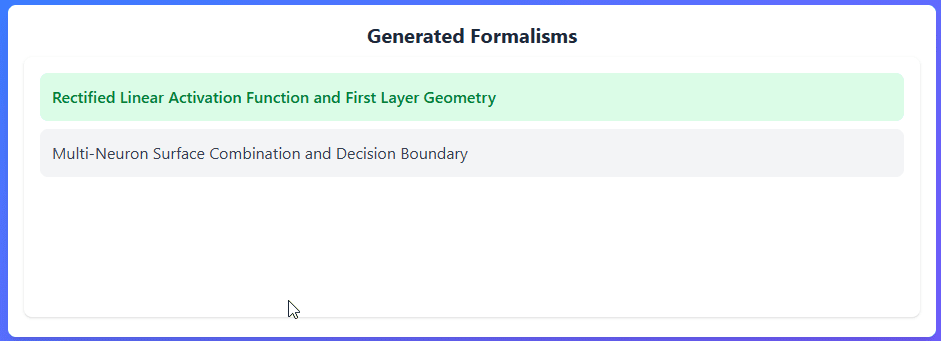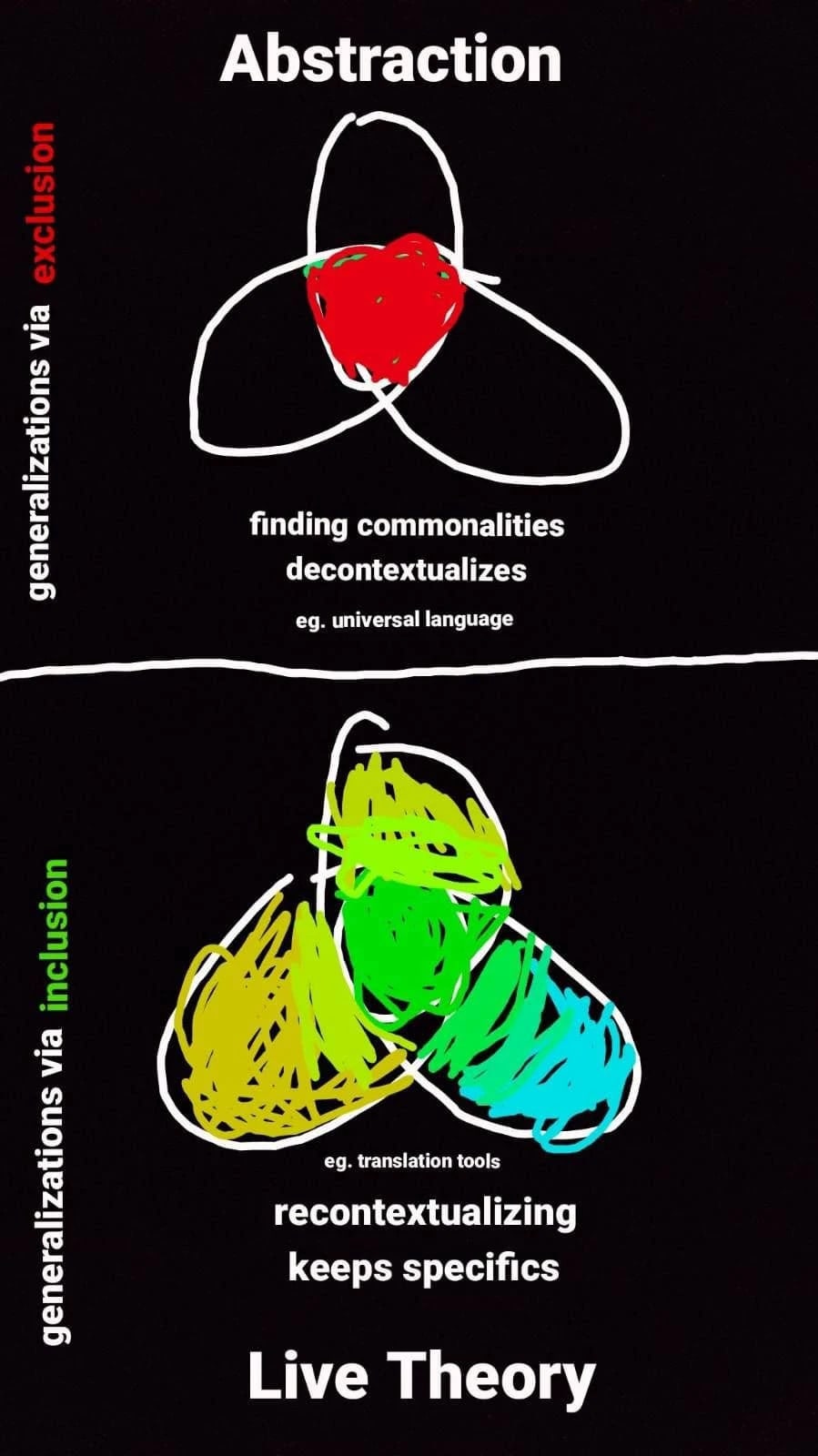Hello everyone, this is Aditya Adiga. I have been part of the “Autostructures project” at AISC 10 and have continued to work on this research at Groundless AI.
I have been building a tool that allows users to mark and port insights or ideas that arise in research conversations into personalised, context-sensitive formalisms. In this post, I want to discuss how this tool works, why it matters, and how cool it is!
Acknowledgements
This work emerged from the AISC Autostructures project hosted by Sahil and Murray, building on Sahil's foundational work on Live Theory. The core ideas were developed in early conversations with Jayson and Sahil, with Djordje and Peter contributing during the initial prototyping stages. Throughout this journey, I've been fortunate to work closely with Sahil, Aditya Prasad, Matt, and Harshit, whose support has been invaluable. My regular discussions with Jayson, Kuil, and Aayush have been essential in navigating this research agenda together.
Many others have shaped this work through their feedback: Abram Demski, TJ, Keith, Murray, Alexandre, Sofi, and others who engaged when I presented publicly, as well as everyone who tested the prototype at the AI Alignment retreat in Ooty and the PIBBSS retreat. The broader communities at AISC, Groundless AI/High Actuation Spaces, Portal, and AI Safety India have provided crucial perspectives, and I thank all who reviewed drafts, especially Aditya, Matt, Sahil, Jayson, Kuil, Aayush, Surabhi, Poorvi, Vatsal, and Alexandre.
I'm grateful to Vatsal and Aditya Prasad for first introducing me to AI safety.
AI Interaction: The Path to Utopia or Dystopia
Our interfaces to AI become our relationship with this technology. Doing this thoughtfully is therefore essential.
Before we jump into the tool, let’s try to understand the importance of building such tools and why it is important to have more human-centred interfaces for AI.
Currently, our interactions with AI, especially Large Language Models (LLMs), are typically transactional; users provide information along with a request and expect immediate responses. By treating these systems as sophisticated answering machines, we are training ourselves to be passive consumers of AI outputs rather than thoughtful participants in problem-solving. Even if you question and try to have a dialogue with AI before coming to some output, you are still passively consuming the meta-layer information, by thinking of AI as something you can talk to. Noticing that this is a choice and there are other forms of relationships that you can have with AI is step zero in the direction of non-passivity. This passivity is dangerous because it can produce results that stray from our actual needs while creating an illusion of efficiency. The consequence of this is learned helplessness in humans, leading to unwarranted trust in AI systems, which is highly concerning and a path that will ultimately lead to gradual disempowerment.
Rather than allowing AI to have a dominant role in the interface, we build:
- with the intention of intuitively supporting human discernment and creativity.
- while avoiding being intrusive or superficial to enhance the meaning-making process in research conversations.[1]
I imagine a time in the near future when we will be able to take intelligence for granted, similar to how we take the internet for granted today. The Internet is the underlying infrastructure for so many things that we use and build without worrying about how it does things under the hood. [2]Similarly, we want AI to be treated as an infrastructure that is backgrounded, only facilitating connections between living beings with a focus on being sensitive to their needs.
Live Conversational Threads(LCT)
The current version of LCT mainly does two things:
- It captures “threads” (independent parts of a conversation) and the relationships between them (contextual, chronological, etc.), enabling richer collective sensemaking without disrupting flow.
- It allows users to mark and port (potential) insights from research interactions to a context that the user desires.
Platform Walkthrough
Below is an example of LCT in action, where threads and the relationship between them are captured and presented to the user.
- LCT captures “threads” (independent parts of a conversation) and the thematic flow of context between them from a live conversation in the form of a Directed Acyclic Graph (DAG) structure.
- A node represents a single "thread" - an independent part of the conversation. Each node contains a context summary of what was discussed in that thread.
- Edges connect nodes and represent contextual relationships - showing how topics flow and relate to each other across the conversation.
- Together, these nodes and edges form a DAG structure that captures the thematic flow of your entire live conversation.
- A node represents a single "thread" - an independent part of the conversation. Each node contains a context summary of what was discussed in that thread.
- LCT allows users to mark points in a conversation through verbal expression of wanting to do so in the conversation or through the interface, where they intuitively identify contextual progress or sense a (potential) insight (highlighted in green). I’ll explain more about the value of this later.

In addition to marking potential progress in a conversation, we want to be able to port these (potential) insights as and when and where required. This is essential; in the live design philosophy, meaning arises in a specific peer-to-peer instance rather than a standalone one. We capitalise on the AI capabilities in formalisation to allow us to produce personalised context-sensitive formalism from these markings.
- The consumers of the marked insight provide information about their research interests or the local context in which they would like to consume this insight.

- The AI-enabled infrastructure in the background considers the potential insight and local context to produce personalised context-sensitive formalisms.
- List of conversational threads for which formalisms are generated.

- Toy model: Causal loop diagram generated for the selected conversational thread(Claude Sonnet 3.7 was used as the AI infrastructure here).

- Math proof generated by DeepSeek Prover v2 for the selected thread (this proof is used to generate a proof using Kimina Prover formally verified in Lean):

Note 1: I expect the mathematical validity and quality to improve over time.
Note 2: Jayson is working on Live Discernment(he will be posting something soon), which is about the relevance of formalisms to the situation it is being used in, which becomes very important in this era of AI-generated formalisms.
Live Theory

The way we do math today is by generalising via excluding things. So in the Venn diagram, you can see that we're excluding the non-common regions and identifying the common region that makes sense independently in all three contexts it is being used, and this becomes a unified, or rather a context-independent, representation of that concept. If I were to consider one of the contexts in the Venn diagram that contains this representation, a lot of information that is sensitive to that context is not considered by this unified theory.
Rather than generalising via exclusion, live theory proposes to generalise via inclusion. Let’s say there is some insight about deception, someone might be interested in this insight from an interpretability perspective, someone else might be interested in this insight from an LLM evaluations perspective, etc. Having a single formula to describe something about a concept as abstract as deception might not be possible. In fact, it doesn’t seem like we have even reasonable contenders for a single definition, nor a hope for one. Instead of this, we acknowledge the presence of the insight and, based on the different contexts it is used in, we produce different formalisms for the same insight, resulting in a pluralism of formalisms that allows us to capture information about the insight which would have been missed if we used a context-invariant unified theory. This allows mere “family resemblances” to be first-class theoretical artefacts, that may contain both rigorous and post-rigorous information. I’ll explain a little more in the next section, but it might sound paradoxical if you aren’t used to it.
Contextual Progress and Potential Insights
Live theory emphasises post-rigorous thinking (which signifies a deeper understanding of a concept beyond formal restrictions). Post-rigour encourages intuitive manipulation/characterisation of some potential insight or idea that can be converted to rigorous arguments (or formalisms) when needed.
An example of developing intuition to identify these post-rigorous objects is sports. When someone like Steph Curry shoots a three-pointer, before the ball has gone in, he has already gotten the feel or the smell that it is going in, so he celebrates before it has even gone in. Another example would be if someone is crossing a football into the middle of the field, the other players intuitively know how they should position themselves on the field to receive the cross and make the best possible play. This intuition or instinct has come to them after practising for many years. The same thing goes for math as well. Once you have solved a bunch of algebraic questions, when you come across an unseen question, you have developed an intuition that allows you to navigate the path to the right answer, without referring to any of the questions you solved previously.
As Terry Tao says:
> [Mathematicians at the post-rigorous stage] no longer need the formalism to perform high-level mathematical reasoning, and are actually proceeding largely through intuition, which is then translated (possibly incorrectly) into formal mathematical language.
One of the goals of live conversational threads, or rather live theory as a whole, is an attempt to treat these post-rigorous intuitions/directions/discernment/insights/hunches as a commodity [3](MFTs-Meta Fungible Tokens, blog on this coming soon). Something that exists in a meta form and can be used to generate personalised mathematical formalisms when, where, and how they are needed.
A lot of research at the highest strata is initiated by these post-rigorous commodities that can be fleshed out by grad students, and now, with increasing possibility, AI. Live Conversational Threads capitalises on this very idea and acts as an underlying infrastructure that allows users to produce, distribute, and consume these commodities.
Who doesn’t like games? (Analogy to understand Live Theory better)
I like to think about live theory as a vast open-world game as opposed to a linear, story-mode campaign.

In a story mode game, every player is forced down the same scripted path and has no choice but to accept to make progress in the game.

Whereas in an open world, you have the participative freedom to wander anywhere, pick up side quests when you wish, or ignore them altogether.
The developer can embed countless missions that remain dormant until your curiosity awakens them.
Each time you accept a quest, your interest in participating in the quest, along with the developers' storyline for this quest, comes together to produce this beautiful gaming experience that is unique to you and feels self-directed rather than imposed.
Cheap, fast, highly accurate AI capabilities turn research into that same open world.
- Imagine having thousands of tireless “mathematician NPCs” (AI infrastructure) waiting in the background.
- The developer has embedded a lot of quests(potential insights) (ex, a hunch about deception in AI models) in this world.
- You are represented by an avatar that has its traits, abilities, personality, etc (personal research interests).
- When you decide to take part in a quest, your avatar’s characteristics (personal research interests), along with the quest (insight), come together thanks to the mathematician NPCs (AI infrastructure), enabling this to produce a personalised, custom storyline (formalism) that is unique to you.
You have the freedom to review, remix, or ignore their work at will, then wander off to explore another quest.
When AI is cheap, fast, and accurate, it becomes possible to scale that which doesn’t scale. The theoretical heavy-lifting is no longer a bottleneck; it scales effortlessly in parallel, yet never dictates your route. Instead of having to create a single grand theory and force it on everyone, you get to build flexible intellectual playgrounds where each researcher can craft the exact tool they need - much like how the developer of an open-world game allows every player to carve their unique path.
Closing Remarks
LCT isn’t about enforcing a new structure, but enabling the right structure to be created when and where it is needed. If the tool helps people stay with ambiguity a little longer, trace evolving trains of thought across time, and sense-make in ways that feel true to their context, that would be a meaningful outcome.
Resources
LCT demo link(alpha version): https://lct-app-515466416372.us-central1.run.app/
Github: https://github.com/aditya-adiga/live_conversational_threads
If you're interested in discussing these ideas further, testing the prototype, funding this work or exploring potential collaborations, I'd be happy to connect.
- ^
Kuil points this out well by saying "to facilitate rather than approximate meaning"
- ^
Here I just want to emphasize the opportunities available from backgrounding, not dismiss the utility of looking under the hood. If anything, it is extremely important for some folk to be constantly checking underneath the hood. There is in fact another project working on this: called live discernment[will post link live as soon as available]
- ^
Here Commodity is more of an aid for intuition; it is more about respecting it as a first-class artefact worthy of attention, iteration and maturation.



